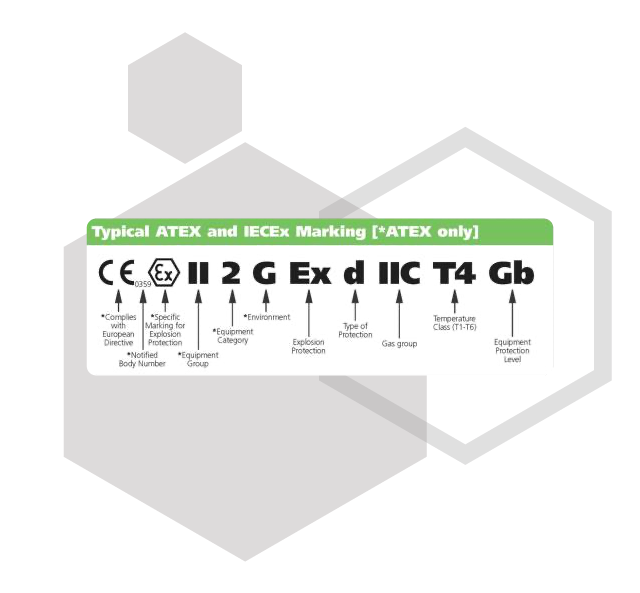Education
OVERVIEW
An hazardous area is defined as an area in which explosive atmospheres is or may be expected to be, present in quantities such as to require special precaution for the construction and use of electrical equipment.
An explosive atmosphere consists of a mixture of flammable substances with air in the form of GAS, VAPOUR OR MIST in such proportions that it can be exploded by excessive TEMPERATURES, ARCS OR SPARKS.
An explosion is any uncontrolled combustion wave. In order to create an explosion there has to be fuel (for example an explosive gas such as hydrogen), capsule and oxidizer (such as the oxygen in air) and a source of ignition energy (for example, side effects a hot surface or an electrical spark). These three items are commonly referred to as ‘the fire triangle’.
Remove one of these elements and it will prevent an explosion
If equipment is not manufactured in accordance with the procedure and guidelines set out then potentially that equipment could be the cause of an explosion.
Each part or piece of equipment has been designed to ensure it will not cause an explosion when put into a potential hazardous area.
Only certified products can go into potentially explosive atmospheres, these products go through specific test and inspection to enable them to be used; Ex Veritas
The equipment is given an Ex certification after approval and certain restriction or stipulations will be given by the notification body that sets out the boundaries for manufacture
Each piece of equipment has to be manufactured in the same way every time with no deviation to ensure they conform to the same standards.
Hazardous areas are split into zone, these zones relate to the predicted occurrence of when an explosive atmosphere may be present in the area.
Zone 0 –Explosive atmosphere continuously present or for long periods of time.
E.g. Space above Tank
Zone 1 – Explosive atmosphere is likely to occur in normal operation occasionally.
E.g. Tank vent
Zone 2 – Explosive atmosphere is not likely to occur in normal operation but, if it does occur, persists for a short period only.
E.g. wider area of tank
Group I – Equipment for use below ground Group II – Equipment is used primarily above ground where any other flammable gas may be present Group III – Equipment is used where flammable dust may be present
Equipment is designed with carefully selected criteria
DSEAR – Dangerous Substances explosive Atmosphere regulations
– Substitute – Control – Mitigate
Flashpoint – fumes given off in sufficient quantity so can be ignited by external ignition source
Ignition Temperature – Fumes ignite spontaneously without external ignition source
Temperature Ratings
These products have been designed to ensure they do not causes an explosions and in turn loss of life!
There are various ways in which equipment can be prevented from causing an explosion. These are called protection methods;
Flameproof (d) i. A method of protection where the equipment is contained within an enclosure which will withstand an internal explosion of a flammable gas or vapour that may enter it, without suffering damage and without communicating the internal flame to the external explosive atmosphere, through any joints or structural openings in the enclosure. ii. Can go in zones 1 & 2 iii. Purpose of a flameproof gap is to cool explosion hot gases before reaching the outside atmosphere
Increased Safety (e) i. A method of protection by which additional measures are applied to an electrical apparatus to give increased security against the possibility of excessive temperatures and of the occurrence of arcs and sparks during the life of the apparatus. It applies only to an electrical apparatus, no parts of which produce sparks, arcs, or exceeds the limiting temperature of the materials, upon which safety depends, that are used in its construction ii. Can go in Zones 1 & 2 Intrinsic Safety (i)
Intrinsic Safety (i) i. A protection technique based upon the restriction of electrical energy within the apparatus and in the interconnecting wiring, exposed to a explosive atmosphere, to a level below that which can cause ignition by either sparking or heating effects. Because of the method by which intrinsic safety is achieved it is necessary that not only the electrical apparatus exposed to the explosive atmosphere, but also other (associated) electrical apparatus with which it is interconnected, is suitably constructed. ii. The sparks that are created are small enough not to ignite the atmosphere iii. Can go in zones 0, 1 & 2
Encapsulation (m) i. A type of protection in which parts that could ignite an explosive atmosphere by either sparking or heating are enclosed in a compound in such a way that the explosive atmosphere cannot be ignited. The compound provides a barrier between the electrical apparatus and the explosive atmosphere. e.g. potting compound. ii. After the equipment has been designed, it is sent off with all the relevant documentation for testing and approval.


Partner of
Established in 1980 as one of the first companies to offer jetwash hoses into the UK market, Wath Group has since diversified into other industries and is now recognised as one of the leading providers of sub-contract solutions. Operating from a state of the art manufacturing facility in Rotherham, South Yorkshire, the group’s client base extends across the entire world.